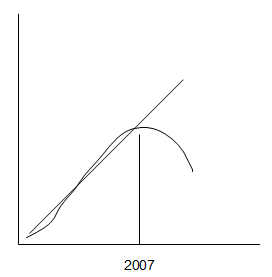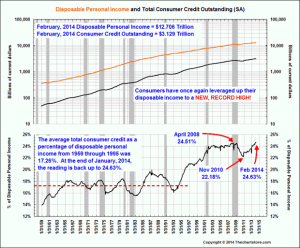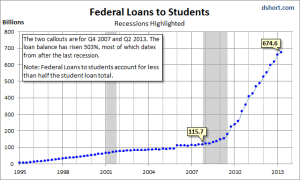
A Few Thoughts on Reviving Biomedical Research in a Deflationary Era
A few days back, we wrote a commentary titled ‘Dangerous Central Planners Coming to Rescue US Biomedical Research’. It was based on a PNAS article by Bruce Alberts, Marc W. Kirschner, Shirley Tilghman, and Harold Varmus titled Rescuing US biomedical research from its systemic flaws.
Despite our criticism of the previous article, we actually find a few positive aspects of it, most important one being the authors’ interest in revisiting long-term history.
The idea that the research enterprise would expand forever was adopted after World War II, as the numbers and sizes of universities grew to meet the economys need for more graduates and as the tenets of Vannevar Bushs Science: The Endless Frontier encouraged the expansion of federal budgets for research (1). Growth persisted with the coming of age of the baby boom generation in the late 1960s and 1970s and a vibrant US economy. However, eventually, beginning around 1990 and worsening after 2003, when a rapid doubling of the NIH budget ended, the demands for research dollars grew much faster than the supply. The demands were fueled in large part by incentives for institutional expansion, by the rapid growth of the scientific workforce, and by rising costs of research. Further slowdowns in federal funding, caused by the Great Recession of 2008 and by the budget sequestration that followed in 2013, have significantly exacerbated the problem. (Today, the resources available to the NIH are estimated to be at least 25% less in constant dollars than they were in 2003.)
This is an acknowledgement of the deflationary environment we live in, something this author predicted and had been talking about since 2005 and told to every biomedical scientist, who would listen (# close to 0).
The only thing I can expect looking forward is deflation. People borrowed from their future, believing that the future will be good. Once this assumption turns false, there will be more and more unwillingness to borrow, as well as more destruction of previous debts through defaults and bankruptcies. Credit-based economies show inflation during the credit expansion phase (such as now), but once the credit expansion phase comes to an end, there is deflation on the other side of the slippery slope.
The above text summarizes almost all aspects of US and Western economies, biomedical research being one of those.
-————————————————
If deflation was expected since 2005, what woke up Alberts and others in 2014? Good question ! Believe it or not, the question was answered in 2005 by this author.
Nonlinearity, Memory Effect and the Markets

It is the stickiness of recent memory that makes people ignore trend changes until it is too late or too obvious. In other words, when a long-term trend changes, most people do not want to acknowledge it until the distance between the expectation and the reality becomes too big to ignore. Henry Bourne, who had been writing on systemic problems in biomedical research for a few years (covered here and here), likely saw the difference in 2010 or 2011 and made a projection of what to come. It took another three years for the matter to be elevated to other important researchers.
That brings us to the suggestions of Alberts et al., which we find are futile. There is only one way to tackle deflation - to be ahead of the trend and see deflation catch up with you, not follow the trend. That means the central planners need to envision what the world will look like, if the deflationary trend continues and then try to be there today.
Why so? It is because while the central planners are implementing their changes, deflationary trend itself will continue to do its work to create more and more backlogs and need for further changes.
-————————————————
If the above discussion is true, is it possible to save the biomedical research communities?
We are not very hopeful, but we made a proposal that we believe will account for the deflationary impact and be ahead of the curve.
US Science Funding Proposal for a Better Alternative
US Science Funding Proposal for a Better Alternative (Part II)
Let us explain the philosophy of the suggestions in a nutshell. We do not believe the existing framework can be saved, because, as we explained, every incremental change to catch up with deflation will be lost on further deflation. A new model needs to be set up and has to slowly take over the space of the existing system, while the existing system dies.
In looking for an alternative to existing model, we went through Nietzsche’s discussion about government (check Nietzsche and the State for example). This space is too short to elaborate on the entire argument, but in brief, the history of USA over the last 80 years matches German history during Nietzsche’s lifetime.
During his lifetime, Nietzsche bore witness to the rise of statism in central Europe, and his disgust with nationalism, liberalism, and mass politics led him to live most of his life in self-imposed exile in Switzerland and northern Italy. Even after resigning from the University of Basel in 1879, he took to living in cheap boarding houses rather than return to his native land, which had undergone a dramatic transformation. When Nietzsche was born in Saxony in 1844, the German Confederation consisted of 43 duchies, principalities, kingdoms, and free cities. He was only four years old when liberals and nationalists began to agitate for the creation of one unified German state. They succeeded in 1871, when Prussia defeated France in the Franco-Prussian War (in which Nietzsche briefly served as a medical orderly).
In less than a decade, the German Confederation went from a motley collection of different dialects, customs, and political associations to a fully modern welfare state driven by mass politics. Contrary to the wartime image of the German Empire, Otto von Bismarcks Germany was just as liberalif not more sothan the other great European powers. Members of the German bund traded away their regional independence for universal manhood suffrage, national healthcare, accident insurance, and old age insurance. A common criminal code, as well as court, civil, and criminal procedures, replaced a cornucopia of local legal systems. During his Kulturkampf, Bismarck attempted to erase the last vestiges of the old order by promoting one way of Germanness, much like Americanism sought to unify the United States around the federal government after the American Civil War.
That history is relevant as a parallel since Alberts et al. are looking into US history since Vannevar Bush (1940s). Nietzsche argued that the greatest cultural figures of Germany lived during a period of complete decentralization (pre-1850s). The linked article talks about Mozart, Beethoven, Schiller, Goethe, and Schopenhauer, but we can also add a number of great mathematicians to the mix (check our commentary - Taking the Eulearian Path).
Following his argument, a decentralization would be the best model for reviving US biomedical science and that is what we proposed. Thankfully, the internet makes the implementation of such a system possible.
-—————————————————————
Edit.
We earlier sent the link to our earlier commentary (not this one) to Henry Bourne and he said:
I see a kernel of truth in your argument, but it’s not helpful overall. Yes, “central planning” won’t fix what’s going on, & has contributed to many of our present problems. But in the real world, it costs LOTS of money to do good science, and there has to be some way to find & distribute that money – thus there will always be commissions/government agencies, and we have to live with them and improve them when we can.
You are essentially saying, forget it – just lie back and enjoy the disaster as best you can. That’s not very helpful.
We are sorry if the previous commentary came across as that, but let us use this place to clarify what we intended to say. We are living in a deflationary environment as this author has been telling everyone since 2005. The article by Alberts et al. is the recognition of
the trend and their proposed suggestions are efforts to catch up. However, by the time they catch up, the deflation will do far more damage. So, Alberts et al. and alike will be chasing their tails for ever.
In a deflationary environment, you have to get ahead of the curve, if you want to build a system that survives another 50 or 100 years. That means some revolutionary thinking (‘nonlinear/disruptive change’) is needed and then it will be necessary to convince others that a disruption to the existing model is the only way to survive. All that takes time and will be disliked by most people in tune with the existing system, but is necessary to go beyond cosmetic changes. That is what we proposed, not sitting on the @ss and enjoying the disaster.
Also, it is very unlikely for deflationary trend to go away soon. Deflation is the opposite of leverage and the following chart shows how leveraged this country currently is. Expect deflation to last for many many decades.

More important chart is the following one. It shows that the last round of leveraging (post 2009) came mostly from increasing student debt. Deleveraging of that aspect will have significant impact on the universities and biomedical researchers going forward.
